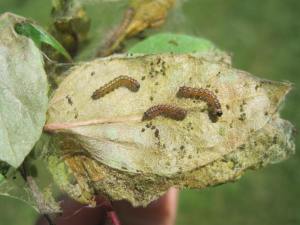“What’s that in the tree? Is it a bag? A spider web?”
“No! It’s tent caterpillars… “
Tent Caterpillars
Oh, oh. Tis the season for insect infestations and tent caterpillars are just one of the insects which attack trees. There are upwards of 26 species of tent caterpillars, but the ones most commonly found in North America are the Forest Tent Caterpillars, Eastern Tent Caterpillars, Western Tent Caterpillars and Fall Webworms. What they all have in common though is their voracious appetites.
Malacosoma love leaves. They weave silk nests in trees for protection and then go to work munching on deciduous tree’s leaves. While Forest Tent Caterpillars have a taste for hardwoods like trembling aspen, oak, ash, maple and white birch, Webworms are quite happy to devour upwards of 85 different species of trees. And in a bad year, they can completely strip a tree of its leaves.
The good news is that most healthy trees can recover from tent caterpillar defoliation in subsequent years. Of course many people find the nests unsightly and the lack of leaves on their beloved trees distressing. Trees that are already stressed due to drought or other infestations may have a harder time withstanding a tent caterpillar defoliation, let alone many years worth. And trees that have been host to multiple tent caterpillar infestations may show reduced radial growth or in some circumstances may even die.
Tent Caterpillar Prevention
There are ways to prevent that from happening though. The most obvious—destroy nests before they have a chance to damage your tree. The best time to undertake this is in the early morning or evening when the caterpillars have returned to their nests for the night.
This can be done in one of a few ways;
- Hope that birds or rodents give you a helping hand by eating the insects
- Use a stick to destroy the nest
- Spray the nest with a hose
- Prune the nest out of the tree
- Treat the tree with TreeAzin® Systemic Insecticide
If TreeAzin sounds familiar to you, it may be because it is an approved treatment in the fight against the emerald ash borer and CLC Tree Services is a licensed user of it. The injectable insecticide is effective in far more reaches than just EAB control though. As per the BioForest website;
In Canada, TreeAzin is registered for use against:
- Emerald Ash Borer
- Gypsy Moth
- Tent Caterpillars
- Spruce Budworm
- Jack Pine Budworm
- Arborvitae Leafminers
- Sawflies, including Birch Leafminer and Pine False Webworm
So if you find a tent in your backyard this summer that was not one you intended to pitch, feel free to contact CLC Tree Services. We can help deter unwanted campers.







Usually, when they make tents in my trees…they make them high enough so that I can’t reach up to knock them down. When that happens, I call my favorite local tree company (you are too far away from virginia!)–http://kenlambtreeco.com/
I even called him once for a large and quite sick oak tree. He treated it with 4 vials of penicillin around the trunk…and it recovered. Thank goodness for all of you who care for the trees and surrounding plants!